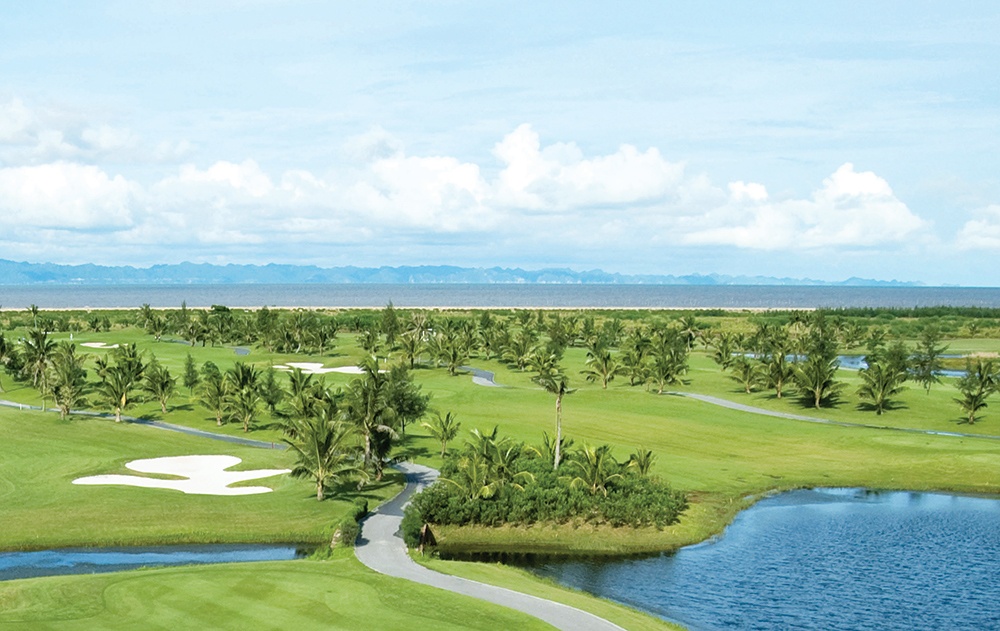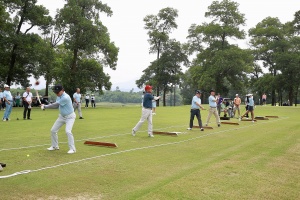Fresh perspective imperative in maintaining golfing craze
 |
| Millions of people around the world love to travel across borders to find the most exciting golf courses |
Dr. Ngo Cong Thanh, representative from the Institute of International Investment Studies (ISC), said at a seminar in early October that by 2030, Vietnam could boast up to 500 golf courses.
“In fact, many provinces nationwide already have clear golf course plans and timelines,” Thanh said.
An increasing number of deep-pocketed investors, both domestic and international, are recognising the lucrative potential of golf investments in Vietnam.
Bac Giang Department of Planning and Investment last week unveiled an ambitious urban golf course project at Nham Bien Mountain. Spanning Dong Son and Tien Phong communes, the venture comprises 88 hectares for a sports tourism area, including a golf course, and an additional 45.8 earmarked for urban development.
The project, estimated at $269.2 million, has enlisted Thai Son Investment and Construction JSC as its sole investor. Thai Son is a subsidiary of Vinhomes, the real estate arm of Vingroup, and is also concurrently spearheading Vinhomes Smart City project.
In a parallel development in Can Tho, the South Korean conglomerate Daewon has showcased interest in a range of investments, notably housing projects, golf courses, and international schools.
In August, Thai Nguyen greenlit the development of a $16.4 million 18-hole golf course in Pho Yen city, with MDA E&C, a South Korean construction and development company, responsible for the investment. The project aims to be operational by Q3 of 2025.
The course will be conveniently situated near Yen Binh Industrial Zone (IZ) in Pho Yen city, which houses a plethora of South Korean investors, notably the Samsung complex in Thai Nguyen.
Dozens more on the way
Discussing the surge in golf investments, Thanh from the ISC attributes the trend to three pivotal drivers.
“Firstly, investors are demonstrating significant interest in golf, knowing that following the 50-year land lease period, they will be prioritised for extensions and given conducive circumstances. This could later allow these golfing locales in Vietnam to evolve into urban areas or IZs,” Thanh said.
“Secondly, investment procedures for golf have been simplified, eliminating the need for top-level approvals. If a project is already in the master planning stage, it can be initiated. Finally, the increasing demand for golf cannot be overlooked.”
To illustrate the point, he cited Quang Ninh province, currently home to six golf courses with plans for an additional 16 over the next 5-7 years. Similarly, Hoa Binh, with its five courses, plans to introduce a total of 21, and the relatively smaller province of Ha Nam is eyeing the addition of three new courses to its existing one.
Other provinces like Bac Giang, Thai Nguyen, and Hai Duong each have ambitious plans for a handful of courses.
Dr. Phan Huu Thang, former director-general of the Foreign Investment Agency under the Ministry of Planning and Investment, reminisced about the initial challenges. He recounted a pivotal moment when Thai investors presented the Vietnamese authorities with golf-related proposals. Intrigued, the government sent a delegation to Thailand to better understand the sport.
“Upon setting foot in Thailand, we were guided to a golf course, which was a revelation for us. At that juncture, we had no golf courses, whereas Thailand had already established 100 and the US had over 1,000,” he said.
Following this overseas exploration, Vietnam inaugurated its first golf course in Dong Mo. “Within a span of a few years, we were granted permission for 10 more courses across the nation,” he added.
 |
Legitimate interest
Presently, a corporation can own several golf courses, and there is ample land for further expansion.
“Binh Phuoc currently lacks a golf course, and our vision is to introduce one there. Whether it’s the mountainous provinces, the central regions, or the highlands, we perceive a high demand. This presents an excellent opportunity for forward-thinking investors,” Thanh said.
A significant shift in perspective among government officials has also been evident. “There was a time when leaders considered golf as a frivolous pastime. Now, both local authorities and businessmen acknowledge golf as a legitimate sport,” Thang said.
Indeed, golf has transformed into a lucrative sector with tangible socioeconomic benefits. It has enhanced local economic development and facilitated Vietnam’s deeper integration into the global arena.
For future growth, Thang emphasised the necessity for a fresh perspective and innovative solutions when investing in and developing golf courses.
“The government needs a broader vision regarding planning, ensuring that every locality has a golf course and making the sport accessible to all. In undeveloped regions, there must be accommodating policies, and even in remote areas, streamlined processes are essential,” he said.
However, while golf courses often signal prestige and growth, some experts voice caution.
Prof. Dang Hung Vo, former Deputy Minister of Natural Resources and Environment said, “Even when bundled with real estate ventures like villas and resorts, many golf course projects still fail to turn a profit. Some have even been abandoned for years.”
The paradox is that many investors continue to pair real estate with golf course projects, Vo added.
“While initially, the economic return may not seem substantial due to the vast land area, over time, the real estate’s value is anticipated to soar, yielding significantly higher profits compared to the golf course alone,” he said.
In reality, real estate giants often effortlessly venture into golf course projects, with local authorities readily allocating land.
“There needs to be more consideration of whether the private interests in land and the potential tourism profit are genuinely balanced,” Vo said. “Without stringent controls, local economies might not reap any benefits.”
 | 250 golfers tee off at 16th Swing for the Kids charity golf event The Swing for the Kids charity golf event returned on October 21 with the participation of nearly 250 golfers. |
 | Swing for the Kids charity event supported by dozens of sponsors In addition to long-term sponsors, the 16th annual Swing for the Kids received new support from the likes of Coninco, Gelex, Vinamika, Seven Stars, and more. |
 | Swing for the Kids 2023 breaks fundraising records The 16th Swing for the Kids charity golf event raised $126,600 through domestic and foreign donors, the biggest amount for the event ever. |
 | Excise tax reduction could propel Vietnam’s golf tour attraction ambitions There may be a huge potential for golf development in Vietman, but some of those involved in the industry say current special consumption tax rules are suppressing it. |
 | Vietnam must take advantage of high-end potential Golf tourism is being strongly considered a treasure that can encourage high-spending tourists to stay longer in Vietnam and return. |
What the stars mean:
★ Poor ★ ★ Promising ★★★ Good ★★★★ Very good ★★★★★ Exceptional
Related Contents
Latest News
More News
- TCP Vietnam opens new youth sports yard in Danang (September 22, 2025 | 18:46)
- 'Run For The Heart' to return to Ho Chi Minh City this September (August 29, 2025 | 15:31)
- LION Championship 25 to feature title showdowns in Khanh Hoa (August 15, 2025 | 14:24)
- AFF Women’s Championship 2025: Vietnam defeat Thailand in tense showdown (August 15, 2025 | 14:21)
- Hung Yen win National U11 Football Championship – Nestlé MILO Cup 2025 (August 06, 2025 | 11:34)
- Vietnam win third consecutive ASEAN U-23 title (July 30, 2025 | 07:00)
- Game-changing tech and startups to star at Vietnam Sport Show (July 18, 2025 | 14:56)
- Vietnam women's team secure 6-0 victory over UAE in Asian Cup qualifiers (July 04, 2025 | 15:32)
- Herbalife Vietnam supports VnExpress Marathon Quy Nhon 2025 (June 17, 2025 | 17:38)
- Vietnam lose first Asian Cup qualifiers match against Malaysia (June 12, 2025 | 16:25)

 Tag:
Tag:






















 Mobile Version
Mobile Version